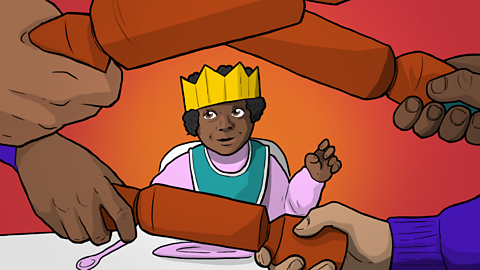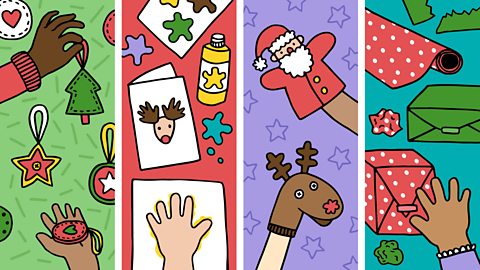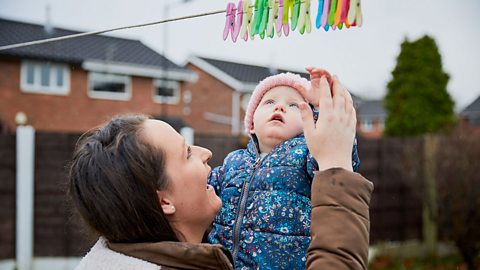The smell of gingerbread, the taste of mince pies, anxiously awaiting the sound of reindeerãÎ what tidings of joy do you remember from your earliest Christmas?
As the weather gets colder and the holidays come around once more, you might be wondering how to make your childãs first Christmas a magical one.
Now is the perfect opportunity to plan activities that encourage learning and development (without breaking your budget on toys) and even start your own festive traditions together.
We asked speech and language therapist Anne McKee to gift us some ideas for making memories your little elves will treasure forever.

Rockinã around the Christmas tree
We all know that babies can hear and recognise music played to them from 16 weeks into pregnancy, but you donãt have to start that early to create a singing and dancing tradition to get into the festive spirit.
Anne suggests taking time to gently dance with baby, and then rockinã it up a bit as they get older.
Choose a fun Christmas chart-topper suitable for your childãs age group and enjoy dancing and moving with them. Not only is this great for bonding, but can help improve their sense of rhythm and language.
Youãll find ãyour songã in no time!
ãPut on Santa hats or anything else a bit special or funny. Spending time having fun and laughing together helps your child feel secure in your love,ã says Anne.
When they feel safe, they are enabled to be curious, explore and learn.
Winter Wonderland treasure box
Take a cardboard box and turn your winter walk into a scavenger hunt for all the things we associate with Yuletide cheer, like fir tree branches and pine cones. You donãt just have to pick up objects from nature.
Items like tinsel, baubles, or even a hat and gloves are also perfect for your winter sensory box.
You could even cut a hole in the box and let your child have a go at feeling whatãs inside: ãAllow your child to put a hand in to lift out an object and explore the different textures and smells,ã says Anne. ãTalk about each item, name it, describe it.ã
Sensory play can help enrich their vocabulary, focusing on nouns and adjectives.
For older children you could also explore reasoning ã why does this item make it into the ãwinterã box, or why is it a ãtreasureã to them?
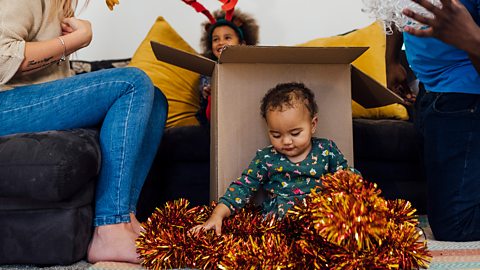
Deck the halls
Decorating the house can be a very special activity to share with your children.
Making a decoration using household materials and objects from nature means you can involve your child every step of the way. This can help them understand planning and following steps.
For example, you could find pine cones together and ask, ãWhat can we use to decorate them?ã, then help them figure out how to hang them up or where to put them.
For those decorating big Christmas trees, Anne suggests leaving out some safe decorations and allowing toddlers to explore at their level.
Experimenting with how to make things stay on the tree or how to take them off creates a fun and dextrous problem to solve.
You can also have them explain the differences between a little pine cone ãtreeã and the big one in the living room and work on those descriptive words.
Real life ice magic
Any fans of Queen Elsa will be enthralled with all things frozen.
No snow outside? No problem! There are many ways to bring the winter weather indoors.
Why not try taking little bits of nature, such as leaves or twigs, and freezing them in a cup or ice cube tray? This can be an enriching experience from start to finish and help your child understand time sequences.
Ask them to describe how the items were ãthenã and how they are ãnowã. Studies show that the best way to help your child be more confident using different tenses is to just talk to them lots about things that happen in the past and future.
If you also have older children, this is a great time to introduce words about temperature, and more sophisticated state-change concepts such as ãfreezeã and ãmeltã.
Do you wanna build a snowman?
If youãre not afraid of a little mess, older children might enjoy building a kitchen snowman with squirty cream, a chocolate drop face and finger biscuit arms!
And if youãre looking for a healthier option, why not try making snowmen with hard-boiled eggs and tiny carrot noses.
Whatever recipe you choose, youãll have loads of fun making them year after year.
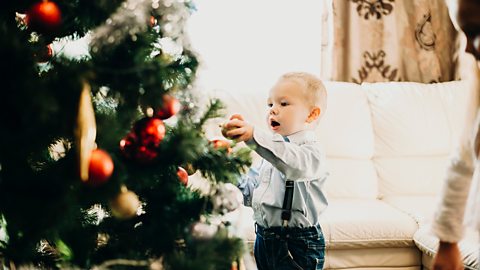
Tis the season
While gift giving isnãt exclusive to the holidays, it certainly makes things feel festive.
Gift-wrapping presents can present (sorry) a great challenge for children to develop fine motor skills and build impulse control. After all, itãs harder to see a present disappear into tempting-looking paper than it is to tear that wrapping off.
ãLet your child get involved in wrapping Christmas presents ã using tape, decorating the parcel,ã says Anne.
It wonãt be as neat as you would do it, but you will have created memories and given your child lots of opportunities to learn!
This can also be an opportunity to develop your little oneãs empathy: encourage them to talk about who the present is for, how they might feel when opening it or what it means to them, what might they say if they received something they love ã or didnãt!
Being able to put themselves in someone elseãs shoes is a great trait to keep all year round, and not just for Christmas.

